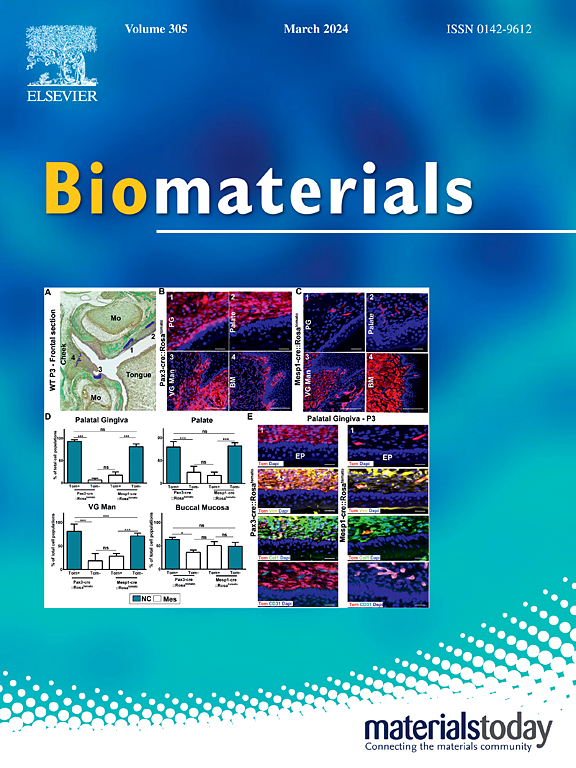Tertiary amine modification enables triterpene nanoparticles to target the mitochondria and treat glioblastoma via pyroptosis induction
IF 12.8
1区 医学
Q1 ENGINEERING, BIOMEDICAL
引用次数: 0
Abstract
Glioblastoma (GBM), the most common primary brain tumor, lacks effective treatments. Emerging evidence suggests mitochondria as a promising therapeutic target, albeit successfully targeting represents a major challenge. Recently, we discovered a group of triterpenes that can self-assemble into nanoparticles (NPs) for cancer treatment. However, unmodified triterpene NPs lack affinity for mitochondria. In this study, using oleanolic acid (OA) as an example, we demonstrated that tertiary amine modification enabled triterpene NPs to selectively target the mitochondria through interaction with translocase of outer mitochondrial membrane 70 (TOM70) leading to effective killing of GBM cells via pyroptosis. We showed that the NPs could be engineered for preferentially penetrating brain tumors through surface conjugation of iRGD, and treatment with the resulting NPs significantly prolonged the survival of tumor-bearing mice. We found that the efficacy could be further improved by encapsulating lonidamine, a mitochondrial hexokinase inhibitor. Furthermore, the observed mitochondria targeting effect through tertiary amine modification could be extended to other triterpenes, including lupeol and glycyrrhetinic acid. Collectively, this study reveals a novel strategy for targeting the mitochondria through tertiary amine modification of triterpenes, offering a promising avenue for the effective treatment of GBM.
叔胺修饰使三萜纳米颗粒能够靶向线粒体并通过诱导焦亡治疗胶质母细胞瘤。
胶质母细胞瘤(GBM)是最常见的原发性脑肿瘤,缺乏有效的治疗方法。新出现的证据表明,线粒体是一个有希望的治疗靶点,尽管成功靶向是一个重大挑战。最近,我们发现了一组可以自组装成纳米颗粒(NPs)的三萜,用于癌症治疗。然而,未经修饰的三萜NPs缺乏对线粒体的亲和力。在本研究中,我们以齐墩果酸(OA)为例,证明叔胺修饰使三萜NPs通过与线粒体外膜70转座酶(TOM70)相互作用,选择性靶向线粒体,从而通过焦亡有效杀死GBM细胞。我们发现,通过iRGD的表面偶联,NPs可以被设计成优先穿透脑肿瘤,并且用所得到的NPs治疗可显着延长荷瘤小鼠的存活时间。我们发现包封lonidamine(一种线粒体己糖激酶抑制剂)可以进一步提高疗效。此外,通过叔胺修饰所观察到的线粒体靶向作用可以扩展到其他三萜,包括芦皮醇和甘草次酸。总之,本研究揭示了一种通过三萜叔胺修饰靶向线粒体的新策略,为有效治疗GBM提供了一条有希望的途径。
本文章由计算机程序翻译,如有差异,请以英文原文为准。
求助全文
约1分钟内获得全文
求助全文
来源期刊

Biomaterials
工程技术-材料科学:生物材料
CiteScore
26.00
自引率
2.90%
发文量
565
审稿时长
46 days
期刊介绍:
Biomaterials is an international journal covering the science and clinical application of biomaterials. A biomaterial is now defined as a substance that has been engineered to take a form which, alone or as part of a complex system, is used to direct, by control of interactions with components of living systems, the course of any therapeutic or diagnostic procedure. It is the aim of the journal to provide a peer-reviewed forum for the publication of original papers and authoritative review and opinion papers dealing with the most important issues facing the use of biomaterials in clinical practice. The scope of the journal covers the wide range of physical, biological and chemical sciences that underpin the design of biomaterials and the clinical disciplines in which they are used. These sciences include polymer synthesis and characterization, drug and gene vector design, the biology of the host response, immunology and toxicology and self assembly at the nanoscale. Clinical applications include the therapies of medical technology and regenerative medicine in all clinical disciplines, and diagnostic systems that reply on innovative contrast and sensing agents. The journal is relevant to areas such as cancer diagnosis and therapy, implantable devices, drug delivery systems, gene vectors, bionanotechnology and tissue engineering.
 求助内容:
求助内容: 应助结果提醒方式:
应助结果提醒方式:


